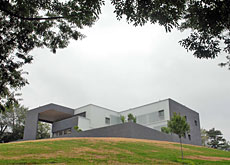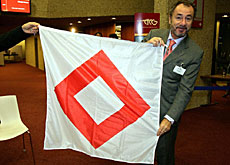Swiss flag up identity concerns

The last thing on the minds of Swiss mercenaries in days gone by as they fought for various European rulers was the colour of their flag, but times have changed.
A proposed amendment to the snappily titled Federal Law on the Protection of Coat of Arms and other Public Insignia, and to the Federal Law on Trademarks and Indications of Source, is currently under discussion.
To curb commercial misuse, the so-called “Swissness” bill has two main goals: better protection and more precise regulations for the Swiss cross and for “Made in Switzerland” designations.
“Swiss law forbids using the Swiss cross or flag on any product for commercial purposes,” Felix Addor, deputy director of the Federal Institute of Intellectual Property, told swissinfo.
“This applies both to foreigners and to Swiss people, but it creates different problems: Swiss companies can’t understand why they can’t use a Swiss cross on a Swiss product; and hardly anything is done against the misuse by companies which have no production in Switzerland. We need to create transparency in our laws.”
With this in mind, the government last month announced measures that would outline who in future could use the Swiss flag – one of the most successful national brands in the world – how to protect the brand and who would enforce the law.
“When you do this, you inevitably have to answer the question: what is the Swiss cross? Can a silver cross on blue background also be seen as a Swiss cross? Therefore an integral part of this project is to define a Swiss cross,” said Addor.
He proposed that in future only companies that fulfil new criteria be allowed to use the Swiss cross and “Made in Switzerland” designations commercially, and that the official Swiss coat of arms – as a sign of the country – should be used by only the government.
“This is about a lot of money because ‘Swiss made’ is the most important brand we have in Switzerland. It’s about who this brand belongs to and who is allowed to use it,” he said, adding that standardising the Swiss cross and flag at the same time “made sense”.
National psyche
The government’s corporate design department took a step towards standardisation when, on January 1 this year, it designated Pantone 485 to be the official background red of the Swiss flag in government logos.
While the exact origins of the Swiss flag are draped in uncertainty, there is no denying Switzerland’s love affair with not only its flag (see gallery) but also the colour red.
“When the morning skies grow red / and over us their radiance shed…” begins the country’s national anthem – at least in its original German language version.
While Swiss independence and democracy traditionally dates from 1291 – when the three central cantons of Uri, Schwyz and Unterwalden swore an oath to the Swiss Confederation – the national flag in its current form dates from only 1889, when the dimensions of the cross were formally established.
“The coat of arms of the federation is, within a red field, an upright white cross, whose [four] arms of equal length are a sixth longer than they are wide,” decreed the government in 1889.

More
Consultation procedure
Branding awareness
Nevertheless, the Swiss Confederation’s decision at the beginning of the 19th century to go with red and white showed a branding awareness centuries ahead of its time.
“Red is a particularly attractive colour,” said Hermann Strittmatter, head of Swiss advertising agency GGK. “The eye notices it three times faster than blue. And there is no more effective colour contrast than red-white!”
This fact has not escaped the marketing experts of countless Swiss companies, including the federal railways and national airline, bank UBS, insurer Swiss Life, retailer Denner and indeed swissinfo’s parent, the Swiss Broadcasting Corporation.
For psychologists red covers the emotional spectrum – from love and hate to danger and anger – but according to Raiffeisen, a cooperative bank which chose a “house red” for its logo, the colour stands for “dynamism, expertise and trust”.
Alinghi, the Swiss sailing syndicate that has won the past two America’s Cups but with a minimal Swiss crew, also uses a red in its logos and campaigns – perhaps in an attempt to boost subconsciously its Swissness.
swissinfo, Thomas Stephens
1339: At the Battle of Laupen Swiss Confederation troops from various cantons wear a long-armed narrow white linen cross stitched on their breasts, sleeves and thighs as a common recognition sign.
1815: After the fall of Napoleon, Swiss regiments who have been fighting for France became Swiss border troops and are presented by the restored Swiss Confederation with the prototype of a modern federal flag: a long, narrow, white cross on a red field.
1840: The legislative assembly rules that the federal flag will replace cantonal war flags for all of Switzerland’s armed forces.
1848: The flag is enshrined in the Constitution of 1848, which in effect transforms Switzerland from a loose Confederation into a federal state.
1889: Parliament rules that the white cross would change from having five equal squares to the arms being one-sixth longer than they were wide.
2007: Government standardises shade of red in flag in government logos.
March 2008: Federal law on the Protection of Coat of Arms and other Public Insignia set to be amended.
While attaching the Swiss cross to products such as food is illegal – even if they originate in Switzerland – red T-shirts, spoons, postcards and other souvenir articles with a large white cross are fine, since the Swiss cross is being used for decorative purposes and not with commercial intent.
The current law also protects the Swiss flag and cross against any “abusive use” and “offence”, although in practice the vagueness and subjectivity of the terms rules out any penalties.
However, at the end of March 2008, when the consultation period ends, severe penalties of up to SFr1 million ($890,000) and five year’s prison could be enforced.

In compliance with the JTI standards
More: SWI swissinfo.ch certified by the Journalism Trust Initiative













You can find an overview of ongoing debates with our journalists here . Please join us!
If you want to start a conversation about a topic raised in this article or want to report factual errors, email us at english@swissinfo.ch.